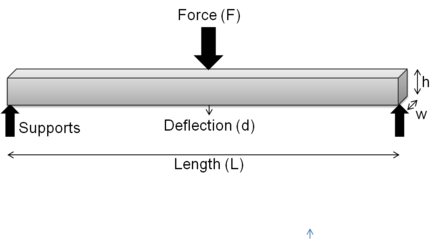Flexural modulus
In mechanics, the flexural modulus or bending modulus[1] is an intensive property that is computed as the ratio of stress to strain in flexural deformation, or the tendency for a material to bend. It is determined from the slope of a stress-strain curve produced by a flexural test (such as the ASTM D 790), and uses units of force per area.[2]

For a 3-point test of a rectangular beam behaving as an isotropic linear material, where w and h are the width and height of the beam, I is the second moment of area of the beam's cross-section, L is the distance between the two outer supports, and d is the deflection due to the load F applied at the middle of the beam, the flexural modulus:[3]
From elastic beam theory and for rectangular beam
thus (Elastic modulus)
Ideally, flexural or bending modulus of elasticity is equivalent to the tensile or compressive modulus of elasticity. In reality, these values may be different, especially for plastic materials.
References
- ↑ Zweben, C.; W. S. Smith & M. W. Wardle (1979), "Test methods for fiber tensile strength, composite flexural modulus, and properties of fabric-reinforced laminates", Composite Materials: Testing and Design (Fifth Conference), ASTM International
- ↑ D 790-03: Standard Test Methods for Flexural Properties of Unreinforced and Reinforced Plastics and Electrical Insulating Materials, West Conshohocken, PA: ASTM International, 2003
- ↑ Zweben, C.; W. S. Smith & M. W. Wardle (1979), "Test methods for fiber tensile strength, composite flexural modulus, and properties of fabric-reinforced laminates", Composite Materials: Testing and Design (Fifth Conference), ASTM International